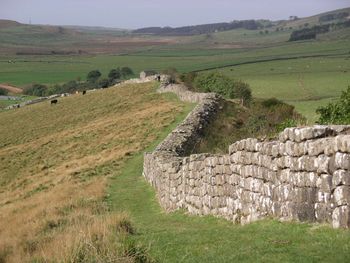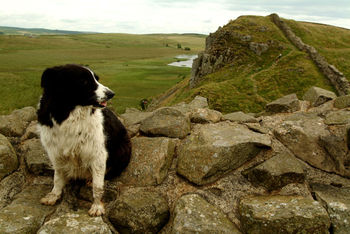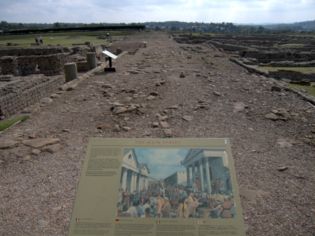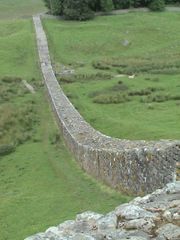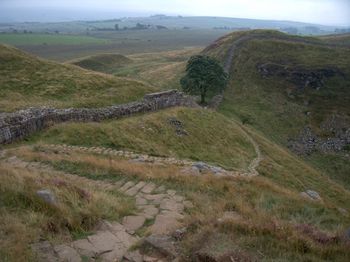Hadrian's Wall
2007 Schools Wikipedia Selection. Related subjects: Architecture; British History 1500 and before (including Roman Britain)
 This article is part of the series on: Military of ancient Rome ( Portal) |
|||
| Structural history | |||
| Roman army ( unit types, legions, generals) |
|||
| Roman navy ( fleets, admirals) | |||
| Campaign history | |||
| Wars | |||
| Battles | |||
| Technological history | |||
| Military engineering (castra, siege engines) |
|||
| Personal equipment | |||
| Political history | |||
| Strategy and tactics | |||
| Infantry tactics | |||
Hadrian's Wall ( Latin: Vallum Hadriani) was a stone and turf fortification built by the Roman Empire across the width of Great Britain to prevent military raids by the tribes of (what is now) Scotland to the north, to improve economic stability and provide peaceful conditions in the Roman province of Britannia to the south, to physically mark the frontier of the Empire, and to separate the unruly Selgovae tribe in the north from the Brigantes in the south and discourage them from uniting.
The name is also sometimes used jocularly as a synonym for the border between Scotland and England, although for most of its length the wall follows a line well south of the modern border — and neither the Scoti tribe nor the English lived in Britain at the time of the wall's construction.
The wall was the northern border of the Empire in Britain for much of the Roman Empire's rule, and also the most heavily fortified border in the Empire. In addition to its use as a military fortification, it is thought that the gates through the wall would also have served as customs posts to allow trade taxation.
A significant portion of the wall still exists, particularly the mid-section, and for much of its length the wall can be followed on foot. It is the most popular tourist attraction in Northern England, where it is often known simply as the Roman Wall. It was made a UNESCO World Heritage Site in 1987. English Heritage, a government organization in charge of managing the historic environment of England, describes it as "the most important monument built by the Romans in Britain".
Dimensions
Hadrian's Wall was 80 Roman miles (73 and a half Modern miles or 117 kilometres) long, its width and height dependent on the construction materials which were available nearby: east of the river Irthing the wall was made from brick shaped stone and measured 10 Roman feet (9.7 ft or 3 m) wide and 5 to 6 metres (16–20 ft) tall; west of the river the wall was made from turf and measured 6 metres (20 ft) wide and 3.5 metres (11.5 ft) high. This does not include the wall's ditches, berms, and forts. The central section measured 8 Roman feet wide (7.8 ft or 2.4 m) on a 10 foot base.
Route
Hadrian's Wall extended from the west from Wallsend on the River Tyne to the shore of the Solway Firth. The A69 and B6318 roads follow the course of the wall as it starts in Newcastle upon Tyne to Carlisle, then on round the northern coast of Cumbria. The Wall is entirely in England and south of the border with Scotland by 15 kilometres (9 mi) in the west and 110 kilometres (68 mi) in the east.
Hadrian
Hadrian's Wall was built following a visit by Roman emperor Hadrian (AD 76–138) in AD 122. Hadrian was experiencing military difficulties in Britain, and from the peoples of various conquered lands across the Empire, including Egypt, Judea, Libya, Mauretania, and many of the peoples were conquered by his predecessor Trajan, so he was keen to impose order. However the construction of such an impressive wall was probably also a symbol of Roman power, both in occupied Britain and in Rome.
Frontiers in the early empire were based more on natural features or fortified zones with a heavy military presence. Military roads or limes often marked the border, with forts and signal towers spread along them and it was not until the reign of Domitian that the first solid frontier was constructed, in Germania Superior, using a simple fence. Hadrian expanded on this idea, redesigning the German border by ordering a continuous timber palisade supported by forts behind it. Although such defences would not have held back any concerted invasion effort, they did physically mark the edge of Roman territory and went some way to providing a degree of control over who crossed the border and where.
Hadrian reduced Roman military presence in the territory of the Brigantes and concentrated on building a more solid linear fortification to the north of them. This was intended to replace the Stanegate road which is generally thought to have served as the limes (the boundary of the Roman Empire) until then.
Construction
Construction probably started in 122 and was largely completed within ten years, with soldiers from all three of the occupying Roman legions participating in the work. The route chosen largely paralleled the nearby Stanegate road from Carlisle to Corbridge, which was already defended by a system of forts, including Vindolanda. The Wall in part follows the outcrop of a harder, more resistant igneous dolerite rock escarpment, known as the Great Whin Sill.
The initial plan called for a ditch and wall with 80 small, gated milecastle fortlets every Roman mile holding a few dozen troops each, and pairs of evenly spaced intermediate turrets used for observation and signaling. The wall was initially designed to a width of 3 metres (10 ft) (the so-called "Broad Wall"). The height is estimated to have been around 5 or 6 metres (16–20 ft). Local limestone was used in the construction, except for the section to the west of Irthing where turf was used instead as there were no useful outcrops nearby. The turf wall was 6 metres wide (20 ft) and around 3.5 metres (11.5 ft) high. Milecastles in this area were also built from timber and earth rather than stone but turrets were always stone.
The milecastles were of three different designs, depending on which Roman legion built them — the Second, Sixth, and Twentieth Legions, whose inscriptions tell us were all involved in the construction. Similarly there are three different turret designs along the route. All were about 493 metres (539 yd) apart and measured 4.27 metres square (46.0 sq ft) internally.
Construction was divided into lengths of about 5 miles (8 km). One group of each legion would create the foundations and build the milecastles and turrets and then other cohorts would follow, building the wall itself. Early in its construction the width of the wall was narrowed to 2.5 metres (8.2 ft) or even less (the "Narrow Wall"). The Broad Wall dimensions can be seen in some stretches of foundations and some milecastle walls — a handy reference for archaeologists trying to piece together the construction chronology.
Within a few years it was decided to add a total of 14-17 (sources disagree) full-sized forts along the length of the wall, including Housesteads and Birdoswald, each holding between 500 and 1,000 auxiliary troops (no legions were posted to the wall). The eastern end of the wall was extended further east from Pons Aelius (Newcastle) to Wallsend on the Tyne estuary. Some of the larger forts along the wall, such as Chesters and Housesteads, were built on top of the footings of milecastles or turrets, showing the change of plan. An inscription mentioning early governor Aulus Platorius Nepos indicates that the change of plans took place early on. Also some time still during Hadrian's reign (i.e., before AD 138) the wall west of the Irthing was rebuilt in sandstone to basically the same dimensions as the limestone section to the east.
After the forts had been added (or possibly at the same time), the so-called Vallum was built on the southern side. It consisted of a large, flat-bottomed ditch 6 metres (20 ft) wide at the top and 3 metres (10 ft) deep bounded by a berm on each side 10 metres (33 ft) wide. Beyond the berms were earth banks 6 metres (20 ft) wide and 2 metres (6.5 ft) high. Causeways crossed the ditch at regular intervals. Initially the berm appears to have been the main route for transportation along the wall. The Vallum probably delineated a military zone rather than intending to be a major fortification, though the British tribes to the south were also sometimes a military problem.
The Wall was thus part of a defensive system which, from north to south included:
- a glacis and a deep ditch
- a berm with rows of pits holding entanglements
- the curtain wall itself
- a later military road (the "Military Way")
- the Vallum — two huge banks with a ditch between.
Roman-period names
The Roman-period names of some of the Hadrian's Wall forts are known: Segedunum ( Wallsend), Pons Aelius ( Newcastle on Tyne), Condercum ( Benwell Hill), Vindobala ( Halton Chesters), Hunnum ( Rutchester), Cilurvum ( Walwick Chesters), Procolita ( Carrowburgh), Borcovicum or Vercovicium ( Housesteads), Vindolanda ( Little Chesters), Aesica ( Great Chesters), Magna ( Carvoran), Vindomora ( Ebchester), Corstopitum ( Corbridge), Habitancum ( Risingham), Bremenium ( Rochester), Ad Fines ( Chew Green) , and also Banna ( Birdoswald Fort), Milecastle 51, Alauna ( Maryport). Note how the modern names of many of these places include the suffix "chester", reflecting the presence of Roman castra.
Arbeia was a supply fort behind the wall.
Garrison
The wall was garrisoned by auxiliary (i.e., non-legionary) units of the army (non- citizens). Their numbers fluctuated throughout the occupation, but may have been around 9,000 strong in general, including infantry and cavalry. The new forts could hold garrisons of 500 men whilst cavalry units of 1,000 troops were stationed at either end. The total number of soldiers manning the early wall was probably greater than 10,000.
They suffered serious attacks in 180, and especially between 196 and 197 when the garrison had been seriously weakened, following which major reconstruction had to be carried out under Septimius Severus. After the harsh suppression of the tribes under Septimius, the region near the wall remained peaceful for most of the rest of the 3rd century. It is thought that many in the garrison may have married and integrated into the local community.
After Hadrian
In the months after Hadrian's death in 138, the new emperor, Antoninus Pius essentially abandoned the wall, though leaving it occupied in a support role, and began building a new wall in Scotland proper, about 160 kilometres (100 mi) north, the Antonine Wall. This turf wall ran 40 Roman miles (about 37.8 mi or 61 km) and had significantly more forts than Hadrian's Wall. Antonine was unable to conquer the northern tribes and so when Marcus Aurelius became emperor, he abandoned the Antonine Wall and occupied Hadrian's Wall once again in 164. It remained occupied by Roman troops until their withdrawal from Britain.
In the late 4th century, barbarian invasions, economic decline, and military coups loosened the Empire's hold on Britain. By 410, the Roman administration and its legions were gone, and Britain was left to look to its own defences and government. The garrisons, by now probably made up mostly of local Britons who had nowhere else to go, probably lingered on in some form for generations. Archaeology is beginning to reveal that some parts of the Wall remained occupied well into the 5th century. But in time the wall was abandoned and fell into ruin. Over the centuries a large proportion of the stone was reused in other local buildings. This continued until the 20th century.
In fiction
- Hadrian's Wall was featured extensively in the movie King Arthur (which depicted the story of the people the Arthurian legends were supposedly based on). The one kilometre (0.6 mi) long replica, located in County Clare, Ireland, was the largest movie set ever built in that country, and took a crew of 300 construction workers four and a half months to build. The fort in the movie where Arthur and his Sarmatian "knights" were garrisoned was based on the Roman fort named Vindolanda, which was built around AD 80 just south of Hadrian's Wall in what is now called Chesterholm, in Northern England. In the movie, the fort is attached to the wall.
- Sycamore Gap, a section of the wall between two crests just west of milecastle 38, is locally known as the "Robin Hood Tree". This location was featured in the 1991 film Robin Hood: Prince of Thieves.
- The humorous 2003 book The Zombie Survival Guide ( ISBN 1-4000-4962-8) by Max Brooks suggests that Hadrian's Wall was built in response to a zombie attack. Brooks writes that in AD 121, undead barbarian hordes descended upon the Romans and were driven back in the area where Hadrian's Wall was then built.
- In the Roman Britain section of Blackadder: Back & Forth, Centurion Blackaddicus, Legionary Baldrickus and Georgius are part of the Roman forces defending Hadrian's Wall from the attacking Scots.
